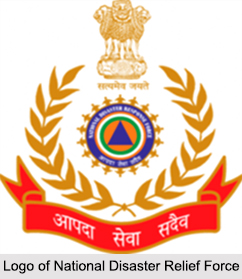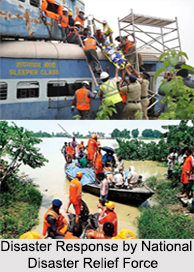 National Disaster Response Force (NDRF) is a specialised force constituted for the purpose of specialist response to a threatening disaster situation or disaster. It was formed under the Disaster Management Act in 2005. The apex body for Disaster Management in India is the National Disaster Management Authority (NDMA) under the chairmanship of the Prime Minister. When calamities of severe nature occur, the Central Government is responsible for providing aid and assistance to the affected state. National Disaster Response Force is also able to respond to radiological, nuclear, biological and chemical disasters.
National Disaster Response Force (NDRF) is a specialised force constituted for the purpose of specialist response to a threatening disaster situation or disaster. It was formed under the Disaster Management Act in 2005. The apex body for Disaster Management in India is the National Disaster Management Authority (NDMA) under the chairmanship of the Prime Minister. When calamities of severe nature occur, the Central Government is responsible for providing aid and assistance to the affected state. National Disaster Response Force is also able to respond to radiological, nuclear, biological and chemical disasters.
Head of National Disaster Response Force
National Disaster Response Force (NDRF) is under the National Disaster Management Authority. The head of the NDRF is designated as "Director General". The Director Generals of NDRF are IPS officers on deputation from Indian police organisations. Director General wears the uniform and badges of rank of an army three-star general.
Composition of National Disaster Response Force
National Disaster Response Force (NDRF) is a force of 12 battalions, organised on Para-military Forces of India:
•Border Security Force (3)
•Central Reserve Police Force (3)
•Central Industrial Security Force (2)
•Indo-Tibetan Border Police (2)
•Sashastra Seema Bal (2)
The total strength of each battalion is approximately 1149. Each battalion is capable of providing 18 self-contained specialist search and rescue teams of 45 personnel each including engineers, technicians, electricians, dog squads and medical/paramedics.
National Disaster Response Force (NDRF) has 4 battalions capable of responding to radiological, nuclear, biological and chemical disasters.
 Deployment of National Disaster Response Force
Deployment of National Disaster Response Force
These National Disaster Response Force battalions are located at 12 different locations in the country. The location is based on the vulnerability profile of the area. The present locations of National Disaster Response Force battalions are as follows:
1. Guwahati, Assam (BSF)
2. Kolkata, West Bengal (BSF)
3. Cuttack, Odisha (CISF)
4. Arakkonam, Tamil Nadu (CISF)
5. Pune, Maharashtra (CRPF)
6. Gandhinagar, Gujarat (CRPF)
7. Bhatinda, Punjab (ITBP)
8. Ghaziabad, Uttar Pradesh (ITBP)
9. Patna, Bihar (BSF)
10. Vijayawada, Andhra Pradesh (CRPF)
11. Varanasi, Uttar Pradesh (SSB)
12. Itanagar, Arunachal Pradesh (SSB)
Disaster Response of National Disaster Response Force
National Disaster Response Force has proved its efficacy with its commendable performance during various disasters. They have saved 1, 33, 192 human lives and retrieved 2760 dead bodies of disaster victims in 73 response operations in the country. The National Disaster Response Force personnel distribute relief supplies including drinking water to the stranded victims. Medical camps were also established to provide medical care to the affected people.
Training of National Disaster Response Force
The National Disaster Response Force personnel are invariably trained in courses like Flood Rescue, Collapsed Structure Search and Rescue, Medical First Responders, Rope Rescue, Nuclear, Biological and Chemical Emergencies, Dignified Disposal of Dead Bodies, etc.
The key responsibility of National Disaster Response Force is an efficient disaster response. Hence, a detailed "Training Regime for Disaster Response" has been prepared by National Disaster Management Authority. The State and Union Territories will also be encouraged to set up Disaster Management training facilities in their respective Police Training Colleges. Training being one of the most important attributes for an efficient force, the Government of India has recognised the recommendations of the National Disaster Management Authority for setting up an apex National Institute of Excellence for Search and Rescue to provide training.
National Disaster Response Force with its swift and highly skilled rescue operations has emerged as most visible and vibrant force of the National Disaster Management Authority.




















